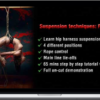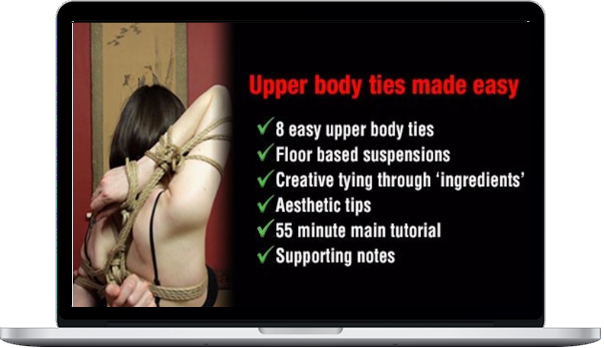Esinem & Nina Russ – Upper body Ties Made Easy
$15.00 $9.00
»Delivery: Within 21 days
Description
Esinem & Nina Russ – Upper body Ties Made Easy
Expanding creative shibari through ‘ingredients’
This tutorial demonstrates and further explains ‘ingredients’ familiar from our other classes, e.g. ‘Tying techniques’, through a variety of simple ‘recipes’. This brings a greater understanding of the engineering and associated aesthetics which develops your creativity safely.
- Two M-shape arm ties
- Two Teppo (rifle bearer) ties
- Teppo with half gote (suspension capable)
- Single choker tie
- Double choker tie
- Floor based suspensions
- Simple high hands gote (takate kote)
You will learn the two main construction techniques used throughout shibari though simple examples: those based on single/double column ties and those using reverse tension. In addition, you will see how different frictions or simple hitches can often be used interchangeably, in the same way culinary ingredients can be substituted, to create your own personalised ‘recipes’. This allows you to move beyond simply copying patterns.
Most importantly, through this understanding of function, you should be able to spot your own mistakes, thus being able to tie creatively and safely with confidence. No tie can be performed precisely the same way on everybody. Flexibilities vary, differences in size or shape will mean ropes never run out at the same time, thus a tie almost always needs some adaptation or macramé. Creativity allows you to tie to fit the body, rather than attempting to make the body fit the tie.
What You’ll Learn In Upper body Ties Made Easy
Course Curriculum
Upper body ties made easy
- M-shape tie (single/double column method) (9:56)
- M-shape tie (reverse tension method) (4:12)
- Teppo (rifle bearer) (single/double column method) (5:42)
- Teppo (rifle bearer) (reverse tension method) (2:43)
- Teppo with half gote (12:09)
- Choker tie (1:54)
- Choker tie floor-based suspension (2:05)
- Double choker tie (3:00)
- Double choker floor-based suspension (4:59)
- High hands with hojo cuffs (9:30)
About Esinem & Nina Russ
About Esinem
Esinem is a shibari artist who has regularly appeared at UK and international events such as Pride, Torture Garden, Erotica, Rubber Ball, Wasteland, Boundcon, Nuit Demonia and recently represented the UK at Japan’s first international kinbaku event, Toubaku. He is also known for his teaching both in the UK and internationally and was co-organiser of the London Festival of the Art of Japanese Bondage and BOUND, Europe’s premier monthly shibari event.
Over the last few years, he has been improving his skills in Japan with the help some of their best known and respected kinbakushi, Arisue Go, Osada Steve, Kinoko Hajime, Kazami Ranki and, grand master of newaza, Yukimura Haruki. Whilst drawing from classical methods, his style is distinctive and epitomizes the art of communicating with rope, often departing from the typical serenity of shibari shows and flying in the face of tradition to produce some striking and unusual performances.
In addition, he has worked on various videos, e.g. Primal Scream’s 2013, artistic collaborations and photo shoots both on and off camera. He has been involved in projects providing inspiration for Tom Ford’s 2013 collection and, Raqib Shaw, an acclaimed artist who has exhibited at the Tate, Metropolitan and White Cube galleries.
He contributed to Rope, Bondage & Power, edited by Lee Harrington and is currently involved with a number of documentaries on kinbaku. He is also author of the first English language tutorial DVDs: ‘Japanese Rope Bondage: Tying people, not parcels’.
About Nina Russ
Nina Russ is a London based, shibari performer, rope artist and educator. She became student of Esinem in 2011 and their collaboration gave birth to BOUND shibari night (2012) and ShibariClasses (2015). She had also the fortune to participate at workshops with different Japanese shibari masters, like: Kazami Ranki, Yukimura Haruki, Kinoko Hajime.
She has performed internationally, most notably at the London Festival of the Art of Japanese Rope Bondage and RopeFest in St.Petersburg. In addition, she participates in numerous artistic, fashion collaborations and local performances. Her passion for rope has lead her on a route of discovery of concepts, philosophy, aesthetics and benefits behind this Japanese discipline.
She sees shibari as an art form which creates deep connection between the participants and also aids personal development. Due to its martial arts roots, it brings self-discipline, efficiency, effectiveness and, thus, growth in confidence and awareness. She believes these skills allow a greater focus on the most important aspects: you, your partner and your shared experience.
More courses from the same author: Esinem, Nina Russ
Delivery Policy
When will I receive my course?
You will receive a link to download your course immediately or within 1 to 21 days. It depends on the product you buy, so please read the short description of the product carefully before making a purchase.
How is my course delivered?
We share courses through Google Drive, so once your order is complete, you'll receive an invitation to view the course in your email.
To avoid any delay in delivery, please provide a Google mail and enter your email address correctly in the Checkout Page.
In case you submit a wrong email address, please contact us to resend the course to the correct email.
How do I check status of my order?
Please log in to DatingCourse account then go to Order Page. You will find all your orders includes number, date, status and total price.
If the status is Processing: Your course is being uploaded. Please be patient and wait for us to complete your order. If your order has multiple courses and one of them has not been updated with the download link, the status of the order is also Processing.
If the status is Completed: Your course is ready for immediate download. Click "VIEW" to view details and download the course.
Where can I find my course?
Once your order is complete, a link to download the course will automatically be sent to your email.
You can also get the download link by logging into your DatingCourse account then going to Downloads Page.
You may also like:
- See more 2 Girls Teach Sex courses
- See more 60 Years of Challenge courses
- See more Adam Armstrong courses
- See more Adam Gilad courses
- See more Adam Lyons courses
- See more Arash Dibazar courses
- See more Bobby Rio courses
- See more Carlos Xuma courses
- See more David Deangelo courses
- See more David Shade courses
- See more David Snyder courses
- See more David Tian courses
- See more David Wygant courses
- See more Dean Cortez courses
- See more Derek Rake courses
- See more FortWorthPlayboy courses
- See more Gabrielle Moore courses
- See more Helena Nista courses
- See more James Marshall courses
- See more Jason Capital courses
- See more Jean Marie Corda courses
- See more Joe Lampton courses
- See more Jon Sinn courses
- See more Lloyd Lester courses
- See more Love Systems courses
- See more Marisa Peer courses
- See more Matt Cook courses
- See more Matt Granger courses
- See more Nick Krauser courses
- See more Pleasure Mechanics courses
- See more Ross Jeffries courses
- See more Talmadge Harper courses
- See more The Modern Man courses
- See more Tom Torero courses
Related products
Total sold: 3










